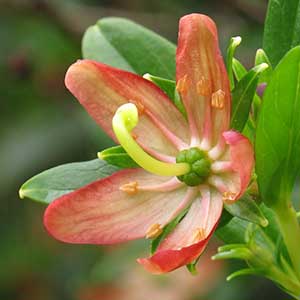Elliottia pyroliflora
copperbush
alternate or seemingly whorled at ends of twigs;
petiole 1–4 mm;
blade elliptic to oblanceolate, (1.5–)2–5 × 0.6–1.4 cm, base cuneate, margins flat, apex mucronate, surfaces glaucous.
terminal, solitary flowers or 2–3-flowered cymes, 2–4 cm;
bracts leaflike, lanceolate, 10–15 mm, margins entire.
5–10 mm, with 1–2, persistent bracteoles distally.
calyx lobes 5, lanceolate, 7–10 × 2–4 mm, apex acute, ciliate along margins especially basally;
corolla 5-lobed, petals pinkish or copper colored, narrowly elliptic, 10–15 mm;
stamens 8(–10);
filaments glabrous;
anthers 1.7–2 mm;
style (persisting in fruit), curved or recurved, 10–12 mm.
5–6-parted, spheroidal, 5–8 mm, finely pitted, glabrous.
0.5–0.8 mm, testa with conspicuous cells.
= 22.
Elliottia pyroliflora
Elliottia pyroliflora has a wider geographic and elevational range than E. racemosa; it is considered difficult to grow.
(Discussion copyrighted by Flora of North America; reprinted with permission.)
- Local floras:
BC,
OR,
WA
- Local Web sites:
Flora NW,
PNW Herbaria
WildflowerSearch
iNaturalist (observations)
USDA Plants Database
- LBJ Wildflower Center
- SEINet
- Plants of the World Online
- Encyclopedia of Life
- Wikipedia
- Google Image Search
